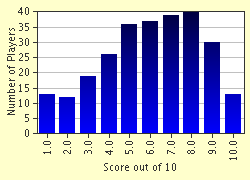Quiz Answer Key and Fun Facts
1. Angiosperms whose life cycles are more than two years are known as ________.
2. Which Swedish botanist invented binomial nomenclature?
3. What name is given to plants whose seeds are enclosed inside a fruit?
4. The leaves of most gymnosperms are __________.
5. Leaves have many pigments. Brown pigments in leaves are called
6. The phloem transports ________ through the plant.
7. Protective fuzz grows on plants that grow at high _____________.
8. The _________________ is the storage area inside a root.
9. Who invented chromotography?
10. These structures are found in all leaves. They are located on the epidermis. They let substances in and out of the leaves and are opened and closed by two guard cells. What are they?
Source: Author
kharkiv
This quiz was reviewed by FunTrivia editor
crisw before going online.
Any errors found in FunTrivia content are routinely corrected through our feedback system.

